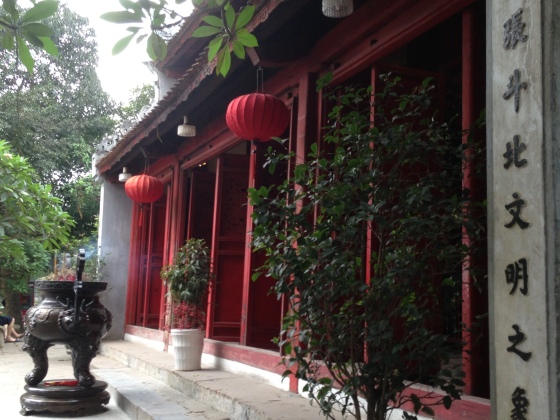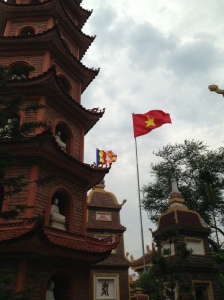It has not been my intention to ignore my blog, it’s just that I don’t seem to be very good at it. This conclusion was reached after realizing that my last post was well over two months ago (and then again two months before that). It’s not that I don’t enjoy writing. Actually, as it turns out, I love it. The problem is that between writing for magazines and working on my book, I’ve become too lazy to write on my blog. But I have a plan. I’ve started writing a regular column (Letter from Hanoi) for a magazine called AsiaLife and I’ve decided to start including what I write there on here (after it’s been published). So to make a start I would like to share June’s column about religious buildings in Hanoi:
Passing a colourful flag fluttering at the end of a dark narrow alley, we reluctantly entered the damp corridor. Cold concrete walls pushing in on both sides gave way to a steep curving staircase, which shielded the busy kitchen beyond. As kittens frolicked on the steps, we followed our guide upwards to the small room on the first floor. Smelling of incense and fried garlic, the room quickly became crowded as the group glimpsed the display of plastic flowers, smoking joss sticks and piles of Choco-pie offerings. Three women sat mending clothes on the mats in front of the shrine, seemingly oblivious to the 10 foreigners who had assembled in the small room. Tucked up here, away from Hanoi’s hustle and bustle, there was a sense of calm and reflection.
Earlier that day I joined one of the regular walking tours offered by Friends of Vietnam Heritage (FVH). Led by local history buff Jura Cullen, the walk explored some of the many chua, den and dinh scattered throughout Hanoi’s Nha Tho (Cathedral) neighbourhood. Prior to this walk, I was unaware that there are three primary types of buildings associated with worship, all of which I incorrectly identified as pagodas, or chua in Vietnamese. In addition to chua, there are den, non-Buddhist temples, as well as dinh, communal houses that usually include shrines to Buddha, local heroes and other gods. Our first stop, the temple with kittens on the stairs, was a dinh.
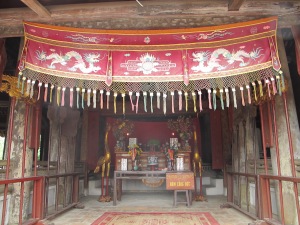 Back downstairs, past the now-sleeping kittens, we emerged into the familiar jumble of cafés, tourist shops and hawkers. Leading us down another alley marked by colourful square flags (signifying the path to the temple), Jura guided us towards an old den, tightly surrounded by a group of concrete tube houses. As I peered through the locked gates, I was surprised to see a large green courtyard beyond the central shrine. Although den such as this one look similar to chua, the architectural design is slightly different. Sometimes including a small shrine to Buddha, the den is primarily a place to worship Confucius, various Taoist divinities, familial ancestors and local heroes.
Back downstairs, past the now-sleeping kittens, we emerged into the familiar jumble of cafés, tourist shops and hawkers. Leading us down another alley marked by colourful square flags (signifying the path to the temple), Jura guided us towards an old den, tightly surrounded by a group of concrete tube houses. As I peered through the locked gates, I was surprised to see a large green courtyard beyond the central shrine. Although den such as this one look similar to chua, the architectural design is slightly different. Sometimes including a small shrine to Buddha, the den is primarily a place to worship Confucius, various Taoist divinities, familial ancestors and local heroes.
Our final stop was the newly reconstructed Chua Ba Da just off Nha Tho Street. Though founded in the 11th century, the current pagoda building is largely brand new. “As a sign of respect, temples are regularly renovated and rebuilt using new and recycled materials,” says Jura. When dating pagodas, it is not the age of the actual structure that is significant, but the historic and sacred foundation that it sits upon.
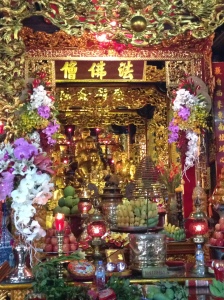 Once inside, the unique chua architecture was clearly visible. Divided into three rooms aligned along a vertical axis, each room supported an individual pitched tiled roof. The first room, a reception and prayer hall, along with the third room, a private area for the monks, supported roofs of the same height. The middle room, housing the shrine, buttressed the highest roof of all. Although Chua Ba Da displays a typical Vietnamese chua design, Jura cautioned against sticking to definite rules when studying the chua, den and dinh. “Although we can make a few generalisations about the architecture and religious symbolism, there are always exceptions to the rules,” she says.
Once inside, the unique chua architecture was clearly visible. Divided into three rooms aligned along a vertical axis, each room supported an individual pitched tiled roof. The first room, a reception and prayer hall, along with the third room, a private area for the monks, supported roofs of the same height. The middle room, housing the shrine, buttressed the highest roof of all. Although Chua Ba Da displays a typical Vietnamese chua design, Jura cautioned against sticking to definite rules when studying the chua, den and dinh. “Although we can make a few generalisations about the architecture and religious symbolism, there are always exceptions to the rules,” she says.
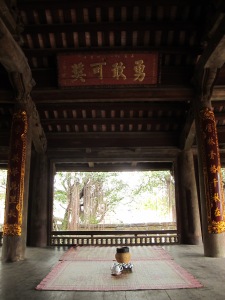 In addition to religious structures, Jura also pointed out many of the intricate architectural details, such as small carved balconies and barely visible windows, which line the area’s many crumbling facades. All but obscured behind the clutter of clothing lines, telecom wires and peeling yellow paint, these details are easy to miss if you don’t know where to look. After a year of walking these streets daily, I am still excited by hidden details that have previously escaped my notice. Now, thanks to Jura and the FVH team, I am inspired to continue walking, discovering and learning.
In addition to religious structures, Jura also pointed out many of the intricate architectural details, such as small carved balconies and barely visible windows, which line the area’s many crumbling facades. All but obscured behind the clutter of clothing lines, telecom wires and peeling yellow paint, these details are easy to miss if you don’t know where to look. After a year of walking these streets daily, I am still excited by hidden details that have previously escaped my notice. Now, thanks to Jura and the FVH team, I am inspired to continue walking, discovering and learning.
FVH is a volunteer group working to preserve and advance Hanoi’s culture and heritage. Jura Cullen offers walking tours independently and through FVH. For more information, visit the website (Fvheritage.org), contact Jura at jura.cullen@cantab.net.or check out her blog: Hound in Hanoi.
This article originally appeared on June 4th, 2014 on the AsiaLife website, click here to see the original

